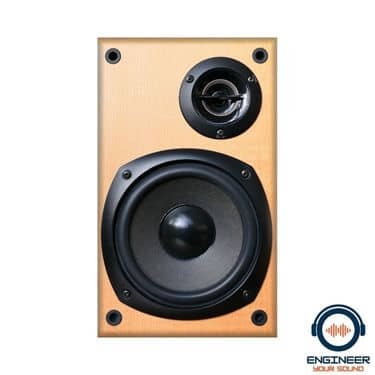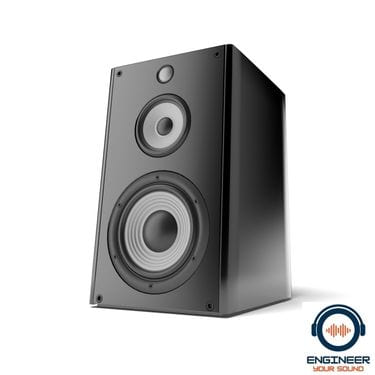With so many options when choosing a speaker, researching and buying the best speaker for your needs can feel daunting and overwhelming. One of the many decisions in this journey is choosing between a 2-way and a 3-way speaker system.
A 2-way speaker is a type of speaker consisting of two individual drivers or cones, typically a woofer for low-frequency sounds and a tweeter for high-frequency sounds.
These drivers are designed to handle specific frequency ranges, allowing for better sound reproduction and clarity. The separation of frequencies helps to minimize distortion and improve overall audio performance.
As an audiophile, I’ve spent countless hours experimenting with different setups to find that perfect balance of clarity, volume, and depth.
In this article, I will delve into the specifics of a 2-way speaker, scrutinizing its purpose and offering a comparison to its 3-way counterpart. By sharing my personal experiences, I hope to provide insights that might guide you when choosing a speaker.

What Do We Mean By A 2-Way Speaker?
A 2-way speaker, as its name suggests, operates with two distinct speaker components for sound production – a tweeter and a woofer.

The tweeter is designed to handle the higher frequency range, typically anything above 2,000 Hertz, delivering crisp and clear trebles. On the other hand, the woofer is responsible for lower frequencies (below 2,000 Hertz), producing rich and deep bass tones.
This division of labour between the two components allows for a focused and efficient handling of the audio spectrum, resulting in a balanced sound output.
From my experience, this setup is excellent for casual listeners and can be quite satisfactory for most settings, from beginners to pros, depending on the quality of the speaker.
The Purpose Of A 2-Way Speaker
In my experience, the 2-way speaker delivers a straightforward, balanced audio experience. Its design focuses on each component on what it does best. The tweeter handles the high frequencies, allowing the nuances of the trebles to shine through. Meanwhile, the woofer takes care of the lower frequencies, ensuring a robust and immersive bass.
The result is a well-rounded sound quality that is more than adequate for most listeners. This simplicity also usually translates to a more cost-effective solution, making 2-way speakers an excellent choice for those seeking high-quality audio without breaking the bank.
In my many years of experimenting with different audio setups, I’ve found that a 2-way speaker system can offer a great return on investment, delivering impressive sound quality at a fraction of the price of more complex systems.
What Do We Mean By A 3-Way Speaker?
In contrast to a 2-way speaker, a 3-way speaker adds an extra component into the mix – the midrange driver. This addition creates a three-tiered approach to sound production, with the tweeter handling high frequencies, the midrange driver dealing with middle frequencies, and the woofer taking care of the low frequencies.

The midrange driver is specifically designed to handle frequencies between the tweeter and the woofer, typically between 200 and 2,000 Hertz. This range covers crucial elements such as the human voice, most musical instruments, and many everyday sounds, contributing to a richer and more detailed audio experience.
As an audiophile, I’ve found that this system can provide a superior level of sound fidelity, capturing subtle nuances and delivering a more immersive audio experience. However, it’s essential to note that this increased performance often comes with a higher price tag and more complex setup.
Plus, just because you have an extra speaker, this does not necessarily mean better clarity of sound. A better build and quality 2-way speaker will outperform a budget 3-way speaker. At the end of the day, the sound you like is the best option, whether delivered by a 2-way or a 3-way speaker.
What Is The Crossover Frequency?
In the realm of audio technology, the term “crossover frequency” refers to the specific frequency at which the sound is divided between the speaker components.
In a 2-way speaker, the crossover frequency is the point at which the tweeter’s responsibility for the high frequencies ends, and the woofer’s duty for the lower frequencies begins. Typically, this is around 2,000 Hertz.
For a 3-way speaker, there are two crossover frequencies: one between the tweeter and midrange driver and another between the midrange driver and woofer. The exact crossover frequencies can vary significantly based on the specific speaker design and manufacturer.
By carefully selecting these crossover points, manufacturers can ensure a smooth transition between the different speaker components, leading to a more cohesive and high-quality sound experience.
Is A 2-Way Or 3-Way Speaker Better?
The answer to this question is not straightforward, as it largely depends on your individual needs, preferences, and budget.
A 2-way speaker, due to its simpler design and fewer components, often comes at a more accessible price point. It offers a balanced sound that caters well to general listening needs, making it an excellent choice for casual listeners or those with budget limitations.
On the other hand, a 3-way speaker, with its additional midrange driver, provides a more detailed and rich audio experience. It excels at reproducing subtle nuances, particularly in the midrange frequency, and can deliver a more immersive listening experience. However, this added complexity often comes with a higher cost.
Personally, I appreciate the intricate balance and superior fidelity that a 3-way speaker can offer. Yet, I also recognize the value and effectiveness of a 2-way speaker in many scenarios.
Ultimately, the choice between a 2-way and a 3-way speaker should be guided by your own listening preferences, the type of audio content you most frequently consume, and your budget.
What Are 2-Way Speakers Good For?
2-way speakers are particularly well-suited for casual listening environments and general use. Their straightforward design means they excel at producing a balanced and robust sound, adequately covering both high and low frequencies. This makes them a great choice for listening to a broad range of music genres, watching movies, or enhancing the audio quality of your television.
Additionally, their lower price point makes them a more accessible choice for those on a budget or those who want good quality sound without a hefty investment.
Also, 2-way speakers often come in compact sizes, making them ideal for smaller rooms or spaces where space is a constraint.
In my journey as an audio enthusiast, I’ve found 2-way speakers to be a versatile and effective solution for various audio needs. Just because they have one less speaker, do not dismiss them as inferior to the 3-way speaker design. There are many fantastic high-end professional 2-way speakers on the market.
Do I Need 2-Way Speakers?
The need for 2-way speakers largely depends on your specific requirements and preferences. If you’re looking for a simple, cost-effective solution that delivers high-quality sound for everyday listening, 2-way speakers are an excellent choice. They provide a balanced audio experience, handling both high and low frequencies competently, and are typically easier to set up and use.
Moreover, if space is a constraint or you’re on a budget, 2-way speakers offer a compact and affordable alternative.
However, if you’re an audiophile or a professional who needs detailed, nuanced sound covering a broad frequency spectrum, you might want to consider 3-way speakers. In my experience, while 2-way speakers are versatile and suitable for a wide range of applications, your decision should be guided by your specific listening needs, audio preferences, and budget.
If you can, I recommend heading to your local speaker dealer to do some listening tests to find the type of sound you like.
Why Are 3-Way Speakers More Expensive Than 2-Way Speakers?
The main reason 3-way speakers tend to be more expensive than 2-way speakers is their increased complexity in design and construction. They contain an additional component, the midrange driver, which adds to the cost of materials and manufacturing.
This driver is designed to handle midrange frequencies, which is crucial for reproducing sounds such as human voices and many high-fidelity musical instruments.
Moreover, careful design and engineering are needed to ensure a smooth transition between the three components (tweeter, midrange driver, and woofer), further adding to the cost.
The more complex crossover system also requires higher precision and quality components, reflected in the price tag.
While the initial investment might be higher for audiophiles like me or those who value a detailed and rich audio experience, the cost difference can be justified by the superior sound quality and performance. However, it’s always important to consider your listening needs and budget when choosing between a 2-way and a 3-way speaker system.
Pros And Cons Of 2-Way Speakers
Pros
- Simplicity and ease of use: With fewer components to manage, 2-way speakers are simple and easy to use. The absence of a dedicated midrange driver reduces the complexity of the setup.
- Cost-effective: 2-way speakers typically cost less than their 3-way counterparts due to the simpler design and fewer components involved.
- Compact size: Due to their simpler design, 2-way speakers are often more compact, making them an ideal choice for smaller rooms or spaces where space is a constraint.
Cons
- Limited frequency range: While 2-way speakers handle high and low frequencies adequately, they may struggle with certain midrange frequencies. This can impact the overall sound quality, particularly for audiophiles or professionals.
- Less detailed sound: Because they lack a dedicated midrange driver, 2-way speakers might not reproduce some subtle nuances in music or other audio content as effectively as a 3-way speaker.
In my experience, the choice between 2-way and 3-way speakers should be influenced by your specific needs, the audio content you most frequently consume, and your budget. While 2-way speakers are more affordable and compact, they may not offer the same audio detail and frequency response level as 3-way speakers. As always, listening to a speaker before purchasing is important to ensure it meets your expectations and preferences.
Final Thoughts
Both 2-way and 3-way speakers have their advantages and potential drawbacks. The choice between the two depends greatly on your listening requirements, preferences, and budget.
While 2-way speakers are cost-effective, compact, and easy to use, making them ideal for general listening purposes and smaller spaces, they may not deliver the mid-range fidelity that a 3-way speaker can provide.
On the other hand, 3-way speakers, with their more complex design and added component, offer a more nuanced and detailed sound profile but come with a higher price tag and may require more space.
As an audiophile, I can appreciate the distinct qualities of both types of speakers and how they can cater to different audio needs. Therefore, it is essential to consider these points when deciding which speaker type best suits your needs. Remember, the ultimate goal is to enhance your audio experience.
